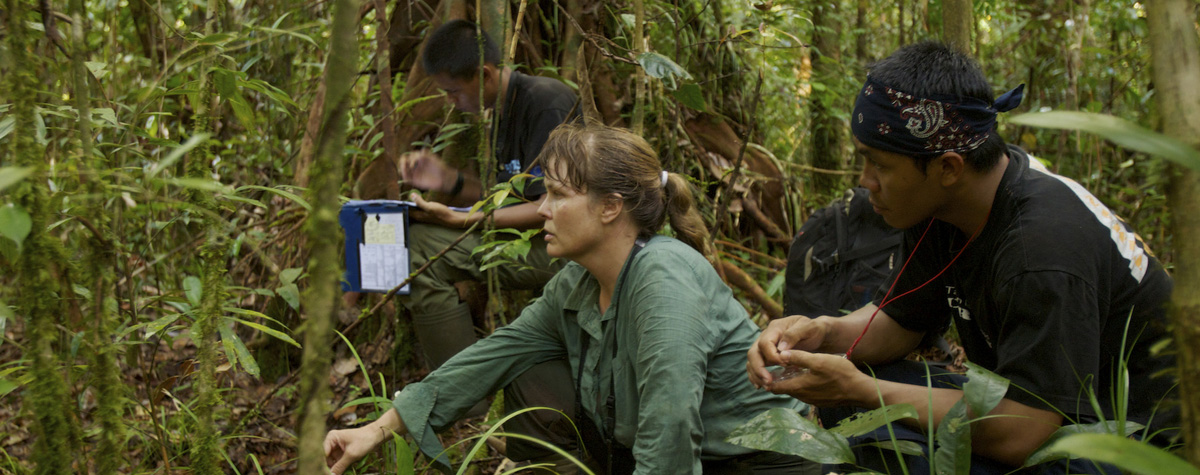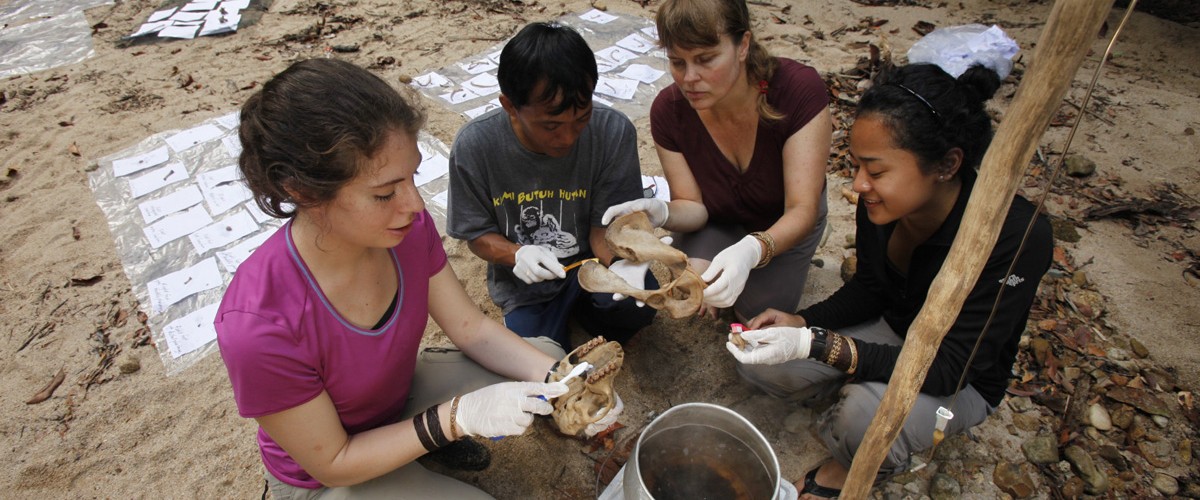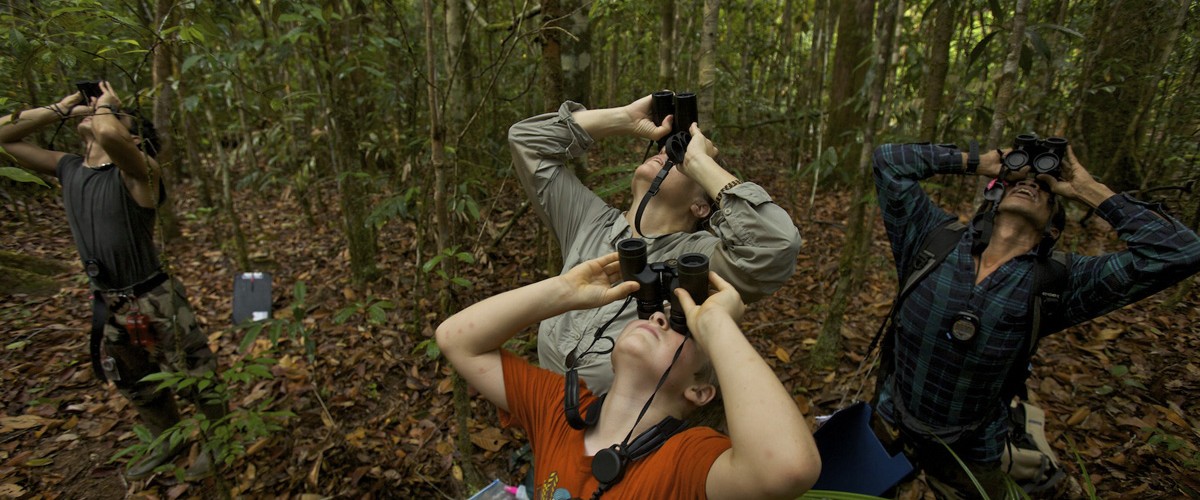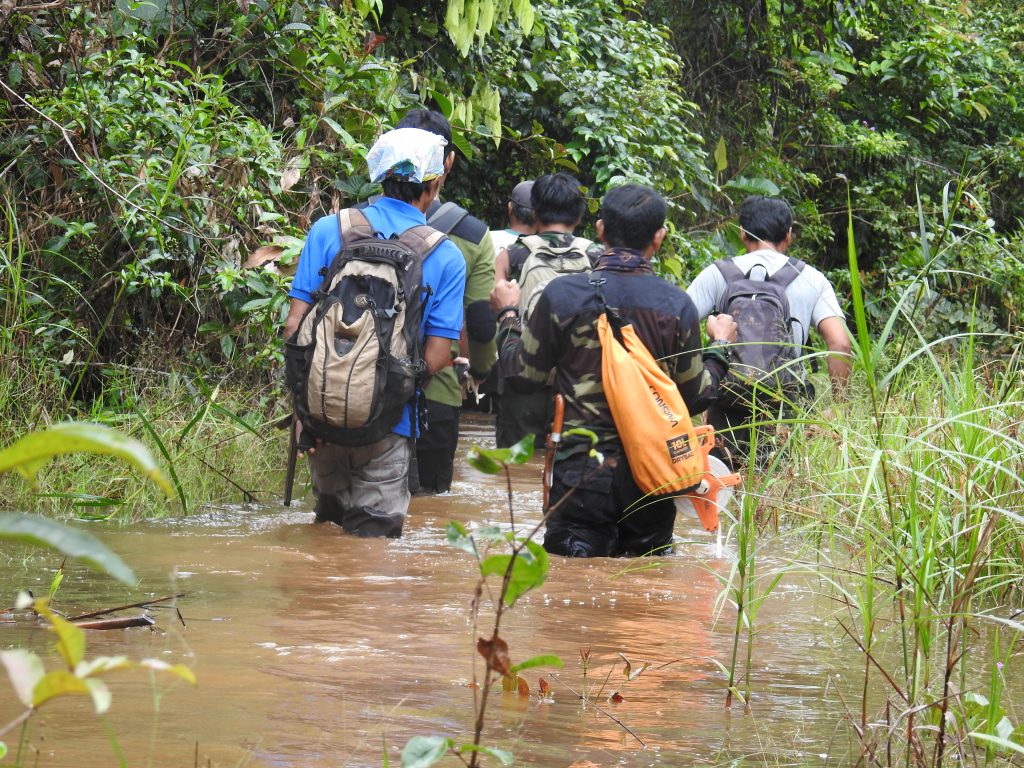By Andre Ronaldo, GPOCP Botanist
For the past year we have been conducting a survey to estimate the population of wild orangutans in Gunung Palung National Park. In order to estimate the orangutan population, we can count the number of nests in trees along transects throughout the park. Because orangutans sleep in a nest each night, and typically build a new nest at least once per day, counting the nests, as well as recording data such as how old the nest is, the level of degradation, the type of tree in which it was built, and the height of the nest, can help us to calculate the total number of orangutans within a given area. In addition to these ground counts, we are also developing and testing a drone survey method, in which a drone is flown over the forest canopy using the coordinates that correspond to the transects walked on the ground. Photos are taken from the drone, which can then be analyzed and also counted for nests. This is allowing us to develop a potentially quicker and less expensive method of surveying orangutan population density.
After a year of fieldwork, our dedicated survey team completed their final expedition to the last two study locations in February. Below, Andre Ronaldo, the project botanist, tells the story of this last excursion and explains some of the predicted findings.

I am a botanist that specializes in the study of trees in mixed Dipterocarp forests, like those found in West Kalimantan, Borneo. I joined Yayasan Palung (GPOCP) in 2019 to work as a phenology expert during the long-term nest survey that began last February. This survey was conducted, in collaboration with the Gunung Palung National Park Office (BTNGP), in order to estimate the population of wild orangutans. In total, this survey took place in 13 locations, over 50 transects positioned within the forest. Our last survey stint took place from February 10th to March 1st of this year. During our last expedition, we surveyed orangutan nests and the phenology of orangutan feeding trees in the villages of Sempurna and Matan Jaya surrounding Gunung Palung National Park.
First, we conducted the survey in Sempurna Village for two weeks. We departed on a four-wheeled truck and travelled through a muddy dirt road. The truck got stuck in the mud, so we had to try pushing it all day long. Fortunately, there was a tractor nearby, and the owner helped to pull our truck. Eventually, we were able to continue our journey and arrived at an area called Jihing where we slept that night.
The survey location in Sempurna Village is a secondary forest, with a freshwater swamp habitat type. In this village there were two survey locations, each with four transects. Each transect was one kilometer long, and separated by a distance of 200 meters. The distance from Jihing to the first location within the forest was 5 km, and the second location was 8 km away. We travelled in a longboat along a small river for about 1 km, then continued walking on foot through hilly roads and flooded swamps. We were helped by porters who carried research and logistic equipment through the extreme terrain.

Once we arrived at the Sempura site, we realized there was a lot of flooding due to heavy rain. We did not build tents on the ground, but instead made a “flying camp” by hanging hammocks with a waterproof flysheet over top. We slept in our elevated hammocks so we could stay dry in the flooded conditions. We also stored all of our food, equipment and personal belongings on higher ground to keep everything dry. Because this area is a freshwater swamp forest, it floods easily during the rainy season. This can be a challenge when conducting a survey, but we were motivated to have our survey run as smoothly as possible.
After we finished in Sempurna, we went straight to our next survey location in the Matan Jaya Village. We departed from Jihing to Matan on a dirt work road. Luckily, there were no obstacles on our journey there. After arriving in the village we travelled another 14 km by car to an old campsite where we stayed. We stayed at this campsite because the forest was too flooded near the transects to put up tents. We wanted to be safe during the floods, because there could be snakes and crocodiles in the water. So, instead of staying close to our transects, we slept further away and hiked 1 km to the survey site each morning.
Similar to the Sempurna location, the survey site in Matan was a secondary forest with a freshwater swamp habitat type, which gets flooded during the rainy season. On our first day in Matan the water reached our knees. Then, it got even higher due to heavy rainfall upriver, and at one point the water reached all the way to our chests! Luckily, the flooding was only on the path, and once we got to the survey site, the flooding was not very high, and the water was always below our knees. The Matan location only had four transects, so we finished this survey location more quickly than the first.
The two sites where we conducted the surveys were secondary forests that were previously logged. To gather information, our colleagues from BTNGP routinely carry out illegal logging patrols in this area. In general, it is very rare to find orangutan nests in these locations. During our survey we most commonly found plants with an average diameter of 20 cm, but very rarely found large trees. Of the 13 locations we surveyed, Matan had the fewest number of nests. The nests we did find were mainly class C and D, which means they were old nests built a long time ago. Because of this, we suspect that the orangutan population here is very small. Orangutans might have moved to other places that are safer, with less human disturbance such as poaching and illegal logging. Also, the habitat here is unfavorable for orangutans, since there are few large, fruiting trees where orangutans can eat, travel and rest.
Estimating the population of orangutans and understanding why the population varies between different areas has crucial conservation implications. Bornean orangutans are critically endangered, and their population continues to decrease at an alarming rate. Around 75% of the remaining wild population lives outside of protected areas like Gunung Palung National Park. Understanding what drives orangutan movement between different areas can inform conservation planning and help us to prioritize our conservation efforts.











